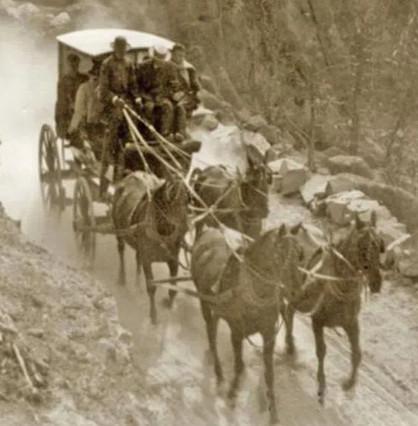Named after Jim Bridger. The first owner of the fort was perhaps the most picturesque figure in early Wyoming. He was often called the ‘Daniel’ Boone of the Rockies. Fort Bridger, which he built and Bridger’s Pass, which he discovered were named for him. This historical fort has several interesting old buildings still standing; the old pony express barn and the Mormon protective wall are still in existence there, and fitting ceremonies will make this site one of the landmarks for history.
It was located 12 miles from Millersville Station and 12 miles from Muddy Station. Thomas O. King was a rider here. According to “Saddles and Spurs by Settle and Settle” he is credited with making the longest ride, which was from Salt Lake to Hams Fork, a distance of 149 miles.
Fort Bridger was established in 1843 (1842?) by Jim Bridger and Louis (Benito) Vasquez. Strategically located on the Black’s Fork River, the fort was second only to Fort Laramie as the most important outfitting point for the emigrants and Mormons travelling the Oregon Trail on the Overland Route between the Missouri River and the Pacific Coast.
Some of the buildings constructed during the Army occupation from 1858 – 1890 are in ruins, but many still stand, preserved and maintained as a reminder of Wyoming’s past. A museum houses artifacts of Indian cultures and the periods of military occupancy. Living-history interpretive demonstrations on military and pioneer life are presented throughout the summer.
Fort Bridger, Wyoming is situated near Carter’s Station, Union Pacific Railroad, Uinta County; now a town of that name. (Expedition Utah)
Note: (coordinates given by Expedition Utah differ).
Fort Bridger is identified as a station site by several sources, but these resources disagree about its function as a Pony Express station. Raymond and Mary Settle suggest that the fort did not serve as a Pony or stage station because there was insufficient grazing land on the government's property. According to them, riders probably stopped briefly to get the mail at Judge W. A. Carter's store and post office before heading to Muddy Creek Station. Pierson, however, argues that a station existed in the fort's quartermaster building. In 1857, General A. S. Johnston's Army of Utah established winter quarters at the fort and maintained a supply contract with the freighting firm of Russell, Majors, and Waddell's—the same firm that operated the Pony Express. This connection, according to Pierson, provides a logical reason for a Pony Express station to exist at Fort Bridger. Franzwa lists Fort Bridger in his Oregon Trail maps, but the trail historian does not identify it as a stage or Pony Express station.(NPS)
"At five P.M. we reached Fort Bridger, one hundred and seventeen miles from the South Pass, and one thousand and twenty-five miles from St. Joseph. Fifty-two miles further on, near the head of Echo Canyon, we met sixty United States soldiers from Camp Floyd. The day before, they had fired upon three hundred or four hundred Indians, whom they supposed gathered together for no good purpose. In the fight that had ensued, four Indians were captured, and the main body chased four miles, but nobody killed. This looked like business. We had a notion to get out and join the sixty soldiers, but upon reflecting that there were four hundred of the Indians, we concluded to go on and join the Indians." (Roughing It)
